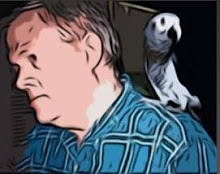Tintin's Adventures Are Enriched with a Cast of Intriguing Characters
Besides Tintin's dog Snowy, his creator Hergé gives Tintin a circle of companions who reappear in various stories to bring distinct personalities and humor to the tales of Tintin. Hergé was associated with the Boy Scouts throughout his life, and in some ways, Tintin is a squeaky clean perennial Scout, with a Scout's bag of tricks. Need a propeller for an airplane? No problem, Tintin whittles one... and then flies the plane. Got a sick elephant? No problem, Tintin finds a remedy, just to kill time, learns the elephant language... and makes his own trumpet so that he can communicate with elephants in their own medium.
Thomson and Thompson, the two detectives with their bumbling and stumbling, contribute slapstick humor to the stories. That is a humor Tintin could not pull off, and we really do not want him to.
The most enduring and endearing of the all of Tintin's friends is Captain Haddock, a character that Charles Dickens or Mark Twain would be proud to claim. When he is introduced in The Crab with the Golden Claws, he is a ship captain with such alcoholism that he has no idea of the criminal activity in his ship. At the end of the book, as he is recovering, he passes out after accidentally drinking a glass... of water.
Read more...
03 June 2009
Tintin's War on Drugs
Cigars of the Pharaoh & the Crab with the Golden Claws
Tintin fought a one-man (or one-boy) war on drugs, ably assisted by his dog Snowy. While drug abuse seems like a modern problem, it has been around for a long time. The fictitious Sherlock Holmes and the real Sigmund Freud shared an addiction (dealt with in the 1976 film, The Seven-Per-Cent Solution - more). The Shadow encountered drug smuggling in the 1937 radio episode, The Temple Bells of Neban. The classic anti-drug film, Reefer Madness or Tell Your Children came out in 1936 (more - and you can watch it online here), not long after Tintin's first (1929-1930) appearance, Tintin in the Land of the Soviets (more).
Although Cigars of the Pharaoh (1932-1934) and The Crab with the Golden Claws (1940-1941) are not the only Tintin stories that refer to drug smuggling, both of them center on the issue. Even their titles refer to...
Read more...
Tintin fought a one-man (or one-boy) war on drugs, ably assisted by his dog Snowy. While drug abuse seems like a modern problem, it has been around for a long time. The fictitious Sherlock Holmes and the real Sigmund Freud shared an addiction (dealt with in the 1976 film, The Seven-Per-Cent Solution - more). The Shadow encountered drug smuggling in the 1937 radio episode, The Temple Bells of Neban. The classic anti-drug film, Reefer Madness or Tell Your Children came out in 1936 (more - and you can watch it online here), not long after Tintin's first (1929-1930) appearance, Tintin in the Land of the Soviets (more).
Although Cigars of the Pharaoh (1932-1934) and The Crab with the Golden Claws (1940-1941) are not the only Tintin stories that refer to drug smuggling, both of them center on the issue. Even their titles refer to...
Read more...
Labels:
drug,
Hergé,
Peter Jackson,
Steven Spielberg,
Tintin
Subscribe to:
Posts (Atom)
